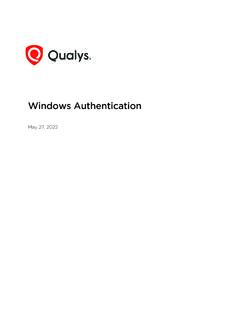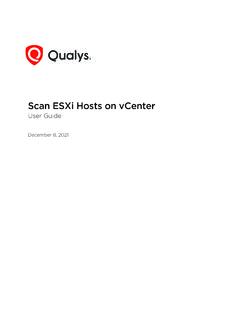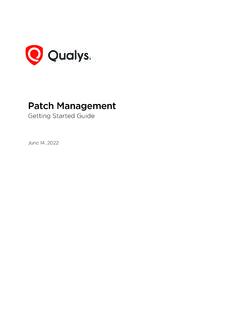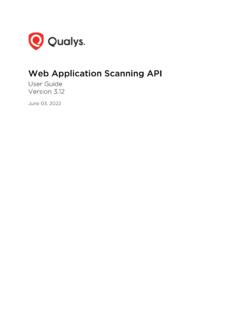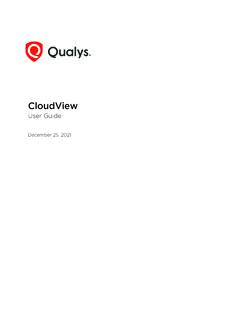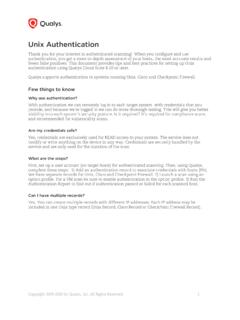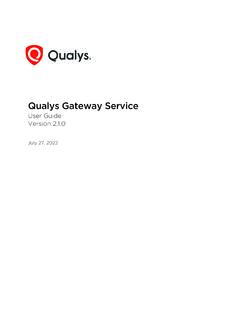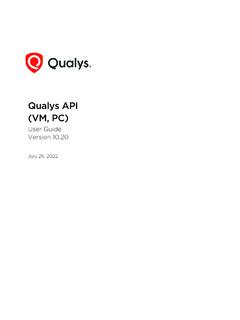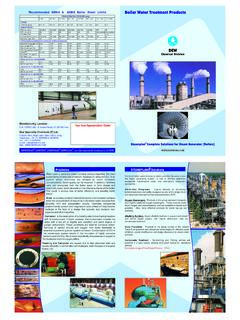Transcription of Qualys API Limits
1 Copyright 2009-2018 by Qualys , Inc. All Rights Reserved. 1 Qualys API Limits The Qualys API enforces Limits on the API calls a customer can make based on their subscription settings. The Limits apply to the use of all Qualys APIs except session V2 API (session login/logout). Default API control settings are provided by the service. Note these settings may be customized per subscription by Qualys Support. API Limits currently apply to the Qualys API for Vulnerability Management and Policy Compliance, not APIs for Qualys apps like CA, WAS, WAF, MD, CM, Asset Management and Tagging API. This document describes the API Limits , how they are implemented by Qualys , and how you can track API usage and view recent API calls, including blocked calls.
2 Tell me about API Controls API controls are applied per subscription based on your subscription s service level. Default settings are provided and these may be customized per subscription by Qualys Support. Concurrency Limit per Subscription (per API): This is the maximum number of concurrent API calls allowed within the subscription for each API (as per service level). Rate Limit per Subscription (per API): Individual rate and count settings are applied (as per service level). Rate Limit Count per Subscription (per API): The maximum number of API calls allowed within the subscription during the configured rate limit period. Rate Limit Period per Subscription (in seconds, per API): The period of time that defines a window when API calls are counted within the subscription for each API.
3 The window starts from the moment each API call is received by the service and extends backwards 1 hour or 1 day (Express/Consultant API Service). SERVICE LEVEL API CONTROLS Express/Consultant API Service Concurrency Limit per Subscription (per API): 1 call Rate Limit per Subscription (per API): 50 calls per Day Not available for Enterprise Account Standard API Service Concurrency Limit per Subscription (per API): 2 calls Rate Limit per Subscription (per API): 300 calls per Hour Enterprise API Service Concurrency Limit per Subscription (per API): 5 calls Rate Limit per Subscription (per API): 750 calls per Hour Premium API Service Concurrency Limit per Subscription (per API): 10 calls Rate Limit per Subscription (per API): 2000 calls per Hour Qualys API Limits 2 How it works When an API call is received, Qualys first checks the concurrency limit.
4 And if the concurrency limit has been exceeded the API call is blocked and an error is returned. In the case where the concurrency limit has not been exceeded, the service checks the rate limit; and if the rate limit has been exceeded the API call is blocked and an error is returned. Concurrency Limit The API concurrency is calculated each time an API call is received and checked against the concurrency limit for the subscription (2 by default for Standard API Service). Example: A subscription for Standard API Service has the default API control settings and there are multiple users. A user makes 2 API calls and both API call instances are running. The API concurrency limit has been reached, so it s not possible for any user to make another successful API call until at least 1 API call instance completes.
5 There must be a maximum of 1 API call instance running at the time the user makes a new API call. When a user makes an API call for an API that has 2 concurrent API call instances already running, then the new API call is blocked, a Concurrency Limit Exceeded error is reported in the XML output, and an entry is added to the Qualys Activity like this: API blocked (concurrency): Rate Limit The rate count and period are calculated dynamically each time an API call is received. The rate period represents a rolling window when API calls are counted. A user may distribute the quota of API calls arbitrarily within the time window. Using a subscription for Standard API Service this quota is 300 API calls per hour. Example: A subscription for Standard API Service has the default API control settings.
6 If 300 API calls are received in a 5 minute period and none are blocked by any API limiting rules, then you need to wait 55 minutes before making the next call to the API. During the wait period API calls will be blocked by the rate limiting rule. When a user makes an API call for an API that is blocked due to exceeding the rate limit, a Rate Limit Exceeded appears in the XML output, and an entry is added to the Qualys Activity Log like this: API blocked (rate): Qualys API Limits 3 Let s take a look Let s review API call history for a subscription for the Standard API Service with the default API Limits Example: An API call was received on April 3 at 10 AM. The service calculated the API rate period by creating a window that extends backwards 1 hour from the time the API call was received to April 3 at 9 AM.
7 The total number of API calls received in the window is 200 so the API call instance received on April 3 at 10 AM runs successfully. Example: 300 API calls were received starting April 12 at 2 PM. The first blocked API call was received on April 12 at 2:30 PM. Users could not run API calls for 30 minutes. The next time an API can be received and run is April 12 at 3 PM, assuming there is a maximum of 1 API call instance currently running at that time. Qualys API Limits 4 Errors Returned in XML output Each API call returns an informational message in the XML output when the API call was blocked because the concurrency limit or rate limit has been exceeded for the API being called. Please note if an API call was blocked, only one error is returned.
8 In the case where the concurrency limit has been exceeded, a Concurrency Limit Exceeded error will be reported (and a Rate Limit Exceeded error will not be reported). Concurrency Limit Exceeded Error An API call returns this error in the XML output in the case where a user makes an API call and the total number of concurrent API instances, which are currently running, exceeds the limit for the subscription. For a V1 API, the error will appear like this: <GENERIC_RETURN> <API name=" " username="acme_es1" at="2017-04-12T14:52:39Z" /> <RETURN status="FAILED" number="1999"> This API cannot be run again until 1 currently running API instance has finished. </RETURN> </GENERIC_RETURN> For a V2 API, the error will appear like this: <SIMPLE_RETURN> <RESPONSE> <DATETIME>2017-04-12T14:52:39Z </DATETIME> <CODE>1960</CODE> <TEXT> This API cannot be run again until 1 currently running API instance has finished.
9 </TEXT> <ITEM_LIST> <ITEM> <KEY>CALLS_TO_FINISH</KEY> <VALUE>2</VALUE> </ITEM> </ITEM_LIST> </RESPONSE> </SIMPLE_RETURN> Rate Limit Exceeded Error An API call returns this error in the XML output in the case where a user makes an API call and the rate limit for the API, as defined for the subscription, has already been reached. In other words, the rate limit count (maximum number of API call instances) has already been reached for the rate limit period. For a V1 API, the error will appear like this: <GENERIC_RETURN> <API name=" " username="acme_es1" at="2017-04-12T14:52:39Z " /> <RETURN status="FAILED" number="1999"> This API cannot be run again for another 23 hours, 57 minutes and 54 seconds. </RETURN> </GENERIC_RETURN> Qualys API Limits 5 For a V2 API, the error will appear like this: <SIMPLE_RETURN> <RESPONSE> <DATETIME>2017-04-12T14:52:39Z </DATETIME> <CODE>1965</CODE> <TEXT> This API cannot be run again for another 23 hours, 57 minutes and 54 seconds.
10 </TEXT> <ITEM_LIST> <ITEM> <KEY>SECONDS_TO_WAIT</KEY> <VALUE>68928</VALUE> </ITEM> </ITEM_LIST> </RESPONSE> </SIMPLE_RETURN> API Usage in HTTP response headers Your subscription s API usage and quota information is exposed in the HTTP response headers generated by Qualys APIs (all APIs except session V2 API). The HTTP response headers generated by Qualys APIs are described below. HEADER DESCRIPTION X-RateLimit-Limit Maximum number of API calls allowed in any given time period of <number-sec> seconds, where <number-sec> is the value of X-RateLimit-Window-Sec. X-RateLimit-Window-Sec Time period (in seconds) during which up to <number-limit> API calls are allowed, where <number-limit> is the value of X-RateLimit-Limit.

